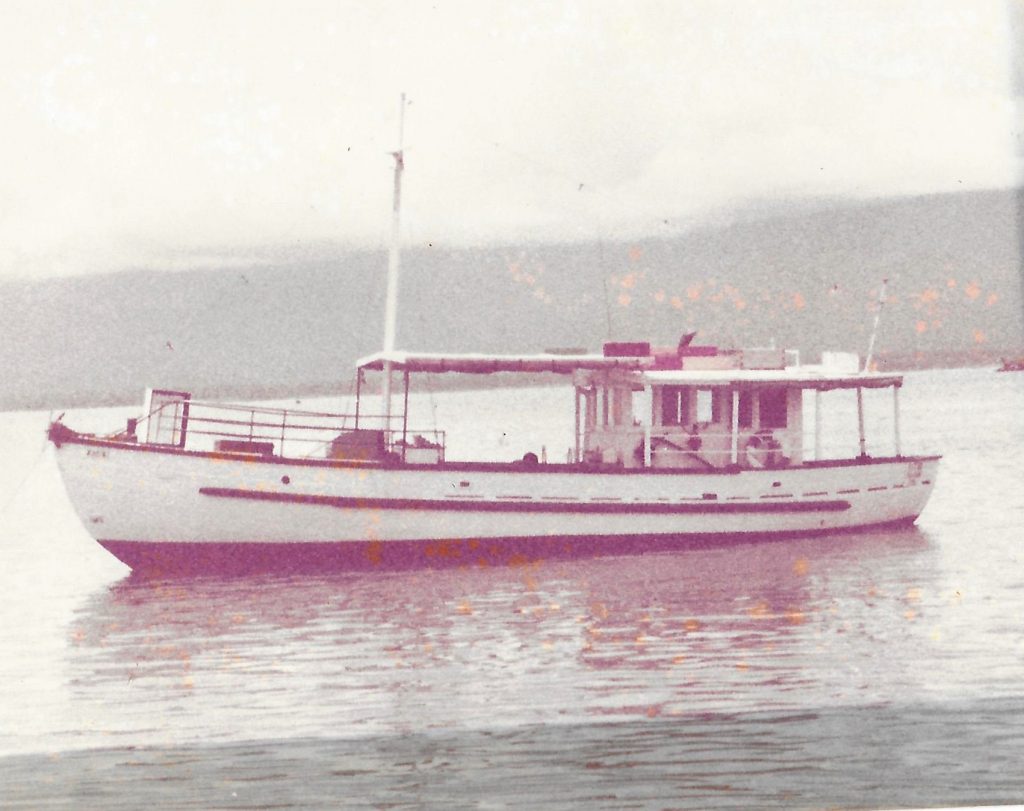I first saw “Katibi” on a crude slipway beneath the volcano on Kar Kar Island north of Madang in New Guinea in early 1979. The lines of her 50’ hull were those of a large traditional yacht with a full-length keel and canoe stern. The ravages of thirty years trading in tropical waters were apparent and the stench of fermenting copra surrounded the whole vessel.
The focsle and forward cabin contained 6 bunks between them and the crew would have to battle armies of cockroaches for occupancy every night. Amidships lay a large cargo hold, capable of carrying several hundred bags of copra or cocoa, covered with timbers and waterproofed by a tarpaulin secured by wooden wedges.
The aft wheelhouse held a huge traditional wooden wheel adjacent to a large brass compass binnacle. There was a crude pair of bunks on the starboard side of the wheelhouse and a filthy bench with a rusty stove on the port. Through a large hatch in the wheel-house sole entry could be gained to the engine room wherein lay a magnificent antique Gardiner 4LW engine with a huge reduction gearbox. The gearbox was operated by a long lever extending through the floor and the skipper looked like a stationmaster changing railway points as he threw it backwards and forward. The engine was governed at 1,200 RPM, a far cry from modern 3,000 RPM diesels, and its fuel consumption was a miracle – in fact we often suspected it manufactured fuel!
Beneath the poop deck lay a small lazaret containing the steering gear operated from the wheel by chains running along either side of the deck beside the wheelhouse. The whole boat was covered by a solid awning in the style of most tropical trading vessels.
She had been built in Nowra in NSW about 1938 as a fishing vessel along traditional lines from red gum scantlings planked with Oregon and the whole underwater area was sheathed in thin copper plating to prevent borer damage. At the start of the war she was commandeered by the Army and taken to New Guinea as a small resupply vessel and finally abandoned in Finschaffen on the north coast in a very sorry state. In 1947 her beautiful lines caught the imagination of a young adventurer and he spent a year rebuilding her, complete with proper sailing rigging, to be used as a trochus boat on the reefs. She operated for many years on the north coast of New Guinea and eventually finished in the hands of a native plantation co-operative from whom my mate, Geoff Wood and I, purchased her.
Not having an opportunity to see the boat in the water, we were somewhat apprehensive about the 400 kilometre trip down the coast to Lae from Madang where we waited for the owners to hand her over after doing their final cargo run from Kar Kar Island. The early morning arrival had not come to fruition by 1600 – a not unexpected development in the part of the world – and we set about purchasing what we “thought” we would need for the journey in anticipation of the boat actually arriving. Four 200 litre drums of fuel were collected (enough to take us to Lae and back as we later found out) and I could not resist a set of brass, oil burning navigation lights discovered covered in dust on a shelf at the chandlers. In theory, nothing should have been needed as Katibi was “in survey” and supposedly fit for sea.
As the sky began to darken in the short tropical twilight the Katibi came into sight cruising between the myriad of palm studded islands which make up the Madang Harbour approaches. Pulling smoothly into the jetty the native skipper soon had the hold cleared by the swarms of crewmembers and I jumped aboard to get a briefing on the boat’s peculiarities. The total information which the skipper thought necessary was how to start the engine using two screwdrivers to arc across the electric terminals on the starter motor because the solenoid, as he put it, “die finis”.
“Some pela wara (water) he come insait” (“Does it leak?”)
“Nogot, lik lik, tasol.” (No, a little, only”)
This was the understatement of the year!
By this time it was pitch black and, as we had no idea how accurate the compass was – no doubt having been last swung during Adam’s youth – we set a course to cut across Astrolabe Bay to strike the coast about 150 kilometres from Madang, which should have been well into daylight the next day. The electric navigation lights did not work as anticipated so the oil models were mounted and lit. These seemed more fitting for the boat in any case as they displayed a warm flickering red and green glow and, even after the electrical system was repaired, the traditional lights were used in preference.
Motoring out through the narrow coral channel from Madang Harbour we felt the effects of the 25 knot wind and were soon leaping up and down on the very steep waves striking dead on the bow. Fortunately, in the tropics, there are seldom the deep sea swells which are found in other areas of the world so waves tend to be the result of local wind and currents, usually short and sharp without huge rollers.
Katibi, without a cargo, as we soon found out, was very sensitive to any waves and I peered out of the darkened wheelhouse to see one of our “volunteer” crew trying to sleep on the cargo hatch. As the vessel crested a wave and dropped violently into the trough he would perform a miraculous feat of levitation and rise a few centimetres from his bed before being squashed firmly down again as the boat rose to meet the next wave. The only place any rest at all could be obtained was on the small rear deck which was awash, as water showered over the rail after every wave – at least it was warm.
About an hour out, I felt we should do an inspection of the vessel and lifted the engine hatch, obliging the helmsman to stand with his feet a metre and a half apart straddling the hole. The old Gardiner was purring away beautifully but to my dismay, the torchlight revealed a foaming whirlpool as the prop shaft spun in water halfway up the gearbox. One of the “volunteers” (who had come along with the thought of trolling for fish on a glossy, moonlit sea) set to work on the hand operated bilge pump while I watched the water level to see if we were winning.
A boat of this size with only 30 centimetres of water in the bilges (and we had considerably more) holds many hundreds of litres and our bilge pump managed about one litre per stroke. The crew slaved away until I confirmed the level was going down and, in relays, we eventually got the boat dry. During this marathon pumping session the senior of a father and son pair who was a font of useless knowledge with his vast experience as a weekend amateur fisherman proclaimed “You young blokes don’t know how to work!” and, seizing the handle of the pump, proceeded to slam it backwards and forwards with such violence that it snapped off. Fortunately there was a set of vice-grips in the tool box and these were fastened to the bare pump shaft, wrapped in rag, so work could continue, albeit twice as hard, for the grips were only half the length of the handle. The son of the culprit did the lion’s share of the pumping, out of embarrassment, when the old fellow started complaining about blisters on his hands after 90 seconds toil.
A careful search of the hull (not a pleasant task being confined in the rancid copra compartments on a wildly pitching vessel) confirmed there was no damage and the water was coming from a briskly leaking propeller shaft stern gland. The crew received my message with some relief and were happy to put in ten minutes at the pump every hour throughout the night.
The first light of dawn appeared over the towering peaks of the Finnesterre Range, allowing us to get a fix and confirm our track from Madang had been remarkably good. As no-one had slept during the night, what with pitching and pumping, it was decided to pull into the tiny bay at Sio which I had often admired from the air. As we drew near the shore and Katibi slid behind the coral reef, the waves abated and we felt the deck steady beneath our feet for the first time in 20 hours. The tiny gap in the reef led into a lovely little harbour, just big enough for two or three boats to anchor in crystal clear water on a white sandy seabed. There was nobody else there and the nearest native village is some distance away so, as soon as the anchor went down, five naked bodies leapt over the side to swim to the sandy beach overhung with the usual coconut palms.
Early the following morning we regretfully left this lovely spot and plunged once more into the seas which had changed little from the day before. As night fell Katibi rounded the point at Finschaffen where she had gained a new lease on life thirty five years earlier and within minutes the wind dropped to zero and the sea became glass. The hopeful fishermen wasted no time and, with heavy lines over the back of the boat streaming brilliant phosphorescence in the water, they shortly had a collection of Barracuda, Mackeral and Dolphin-fish on the stern deck. I was always a little depressed catching Dolphin-fish, despite their lovely flavour, for when they are hauled on board they are the most brilliant creatures in the sea, with every colour of the spectrum gleaming iridescent from their skin. But as they start to die, the colours fade, like a biblical soul departing their bodies, until the fisherman is left with a dull, grey, dead fish without a speck of former beauty.
Because of the stop at Sio we were now considerably behind time and, still having about 10 hours to run, attempted to call on our small CB marine channel radio. Normally this radio had a maximum range of thirty kilometres across water but there was some chance of better performance at night. After several tries to contact a friend in Lae, an answer came clearly from an unknown station asking if they could help. The operator who answered was sitting at his radio in Gosford near Sydney, about 5,500 kilometres away! The vagaries of the stratosphere enabled us to pass our message and our helpful friend placed an international telephone call to tell of our arrival time.
After a magic night cruising down the Huon Gulf on the fabled tropical moonlit water we eventually dropped anchor at Lae, little considering the months of work which lay ahead to bring Katibi back to her former glory.

